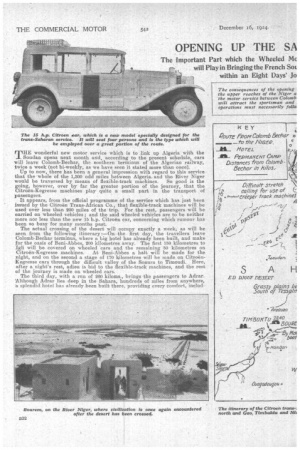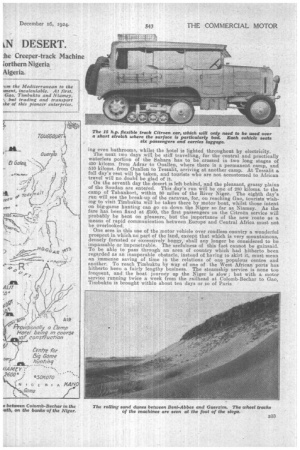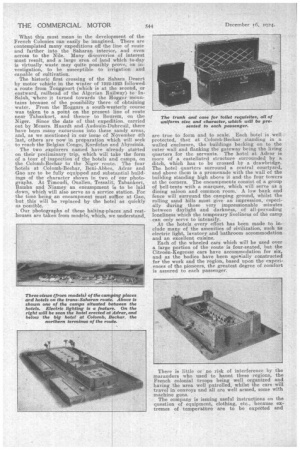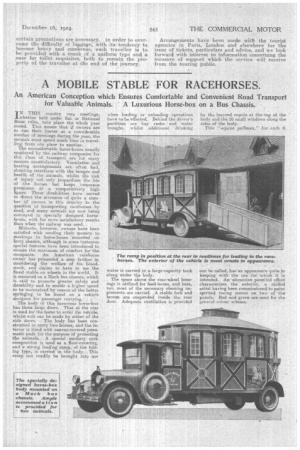OPENING UP THE SA
Page 16

Page 17

Page 18

Page 19

If you've noticed an error in this article please click here to report it so we can fix it.
LN DESERT.
The Important Part which the Wheeled Mc will Play in Bringing the French Sot within an Eight Days' Jo :he Creeper-track Machine iorthern Nigeria Algeria.
rpnE wonderful new motor service which is to link up Algeria with the .1 Soudan opens next month and, according to the present schedule, cars will leave Colomb-Bechar, the southern terminus of the Algerian railway, twice a week (not hi-weekly, as we have seen it stated more than once).
Up to now, there has been a general impression with regard to this service that the whole of the 1,300 odd miles between Algeria and the River Niger would be traversed by means of flexible-track machines. So good is the going, however, over by far the greater portion of the journey, that the Citroen-Kegresse machines play quite a small part in the transport of passengers.
It appears, from the official programme of the service which has just been issued by the Citroen Trans-African Co., that flexible-track machines will be used over less than 200 miles of the trip. For the rest, passengers will be carried on wheeled vehicles ; and the said wheeled vehicles are to be neither more nor less than the new 15 h.p. Citroen car, concerning which rumour has been HO busy for many months past. The actual crossing of the desert will occupy exactly a week, as will be seen from the following itinerary :—On the first day, the travellers leave Colomb-Bechar terminus, where a big hotel has already been built, and make for the oasis of Beni-Abbes, 200 kilometres away. The first 150 kilometres to Igli will be covered on wheeled cars and the remaining. 50 kilometres on Citroen-Kegresse machines. At Beni-Abbes a halt will be made for the night, and on the second a stage of 170 kilometres will be made on CitroenKegresse cars through the difficult valley of the Soaura to Timoudi. Here, after a night's rest, adieu is bid to the flexible-track machines, and the rest
of the journey is made on wheeled cars. • • The third day, with a run of 280 kiloms., brings the passengers to Adrar. 'Although Adrar lies deep in the Sahara, hundreds of miles from anywhere, a splendid hotel has already been built there, providing every comfort, includ lug even bathrooms, whilst the hotel is lighted throughout by electricity. The next two days will be stiff travelling, for the central and practically waterless portion of the Sahara has to be crossed in two long stages of 450 kiloton from Adrar to Ouallen, where there is a permanent camp, and 510 kiloms. from Ouallen to Tessalit, arriving at another camp. At Tessafit a full day's rest will be taken, and tourists who are not accustomed to African travel will no doubt be glad of it. On the seventh day the desert is left behind, and the pleasant, grassy plains of the Soudan are entered. This day's run will be one of 280 kiloms. to the camp of Tabankort, within 80 miles of the River Niger. The eighth day's run will see the break-up of the caravan, for, on reaching Gao, tourists wishing to visit Timbuktu will be taken there by motor boat, whilst those intent on big-game hunting can go on .down the Niger so far as Niamey. As the fare has been fixed at £500, the first passengers on the Citroen service will probably be bent on pleasure, but the importance of the new route as a means of rapid communication between Europe and Central Africa must not be overlooked.
One sees in this use of the motor vehicle over roadless country a wonderful prospect in which no part of the land, except that which is very mountainous, • densely forested or excessively boggy, shall any longer be considered to be impassable or impenetrable. The usefulness of this fact cannot be gainsaid. To be able to pass through an area of country which had hitherto been regarded as an insuperable obstacle, instead of having to skirt it, must mean an immense saving of time in the relations of one populous centre and another. To reach Timbuktu by way of one of the West African ports has hitherto been a fairly lengthy business. The steamship service is none too frequent, and the boat journey up the Niger is slow ; but with a motor service running twice a week from the railhead at Colomb-Bechar to Gao, Timbuktu is brought within about ten days or so of Paris.
What this must mean in the development of the French Colonies can easily be imagined. There are contemplated many expeditions off the line of route and farther into the Saharan interior, and even across to the Nile. Many discoveries of interest must result, and a large area of land which to-day is virtually waste may quite possibly prove, on investigation, to be susceptible to irrigation and capable of cultivation.
The historic first crossing of the Sahara Desert by motor vehicle in the winter of 1922-1923 followed a route from Touggourt (which is at the second, or eastward, railhead of the Algerian Railway) to InSalah, -where it turned towards the Hoggar mountains because of the possibility there of obtaining water. From the Hoggars a south-westerly course was taken to a point on the present line of route near Tabankort, and thence to Bourem, on the Niger. Since the date of that expedition, carried out by Messrs. Haardt and Audouin-Dubreuil, there have been many excursions into these sandy areas, and, as we mentioned in our issue of November 4th last, others are now in preparation which will seek to reach the Belgian Congo, Kordofan and Abyssinia.
The two explorers named have Already started on their preliminary trip, which will take the form of a tour of inspection of the hotels and camps, on the Colomb-Bechar to the Niger route. The four hotels at Colomb-Bechar, Beni-Abbes, Adrar and Gao are to be fully equipped and substantial buildings of the character shown in two of our photographs. At Timoudi, Ouallen, Te,ssalit, Tabankort, Baanba and Niamey an encampment is to be laid down, which will also serve as a service station, For the time being an encampment must suffice at Gao, hut this will be replaced by the hotel as quickly as possible.
Our photographs of these halting-places and resthouses are taken from models, which, we understand are true to form and to scale. Each hotel is well protected, that at Colomb-Bechar standing in a walled enclosure, the buildings backing on to the outer wall and flanking the gateway being the living quarters for the servants. The hotel at Adrar is more of a castellated structure surrounded by a ditch, which has to be crossed by a drawbridge. The hotel quarters surround a central courtyard, and above them is a promenade with the wall of the building standing high above it. and the four towers at the corners. The encampments consist of a group of bell-tents with a marquee, which will serve as a dining saloon and common room. A low bank and fence will surround the camping ground, whilst the rolling sand hills must give an impression, especially during those very impressionable minutes between daylight and darkness, of all-pervading loneliness which the temporary liveliness of the camp can only serve to intensify. At the hotels every effort has been made to include many of the amenities of civilization, such as electric light, lavatory and bathroom accommodation and an excellent cuisine.
Each of the wheeled cars which will be used over a large portion of the route is four-seated, but the Citroen-Kegresse cars have accommodation for six, and as the bodies have been speCally constructed for the work and the region, based upon the experiences of the pioneers, the greatest degree of comfort is assured to each passenger.
There is little or no risk of interference by the marauders who used to haunt these regions, the French colonial troops being well organized and having the area well patrolled, whilst the cars will travel in convoys and all are well armed, some with machine guns. The company is issuing useful instructions on the question of equipment, clothing, etc., because extremes of temperature are to be expected and
certain precautions are necessary. En order to overcome the difficulty of 'luggage, with its tendency to become heaYy and cumbrous, -each traveller is to be provided with a trunk of a uniform type and a case for toilet requisites,' both to remain the property of the traveller at the end of the journey.. Arrangements have been made with the tourist agencies in Paris, London and elsewhere for the, issue of tickets, particulars and advice, and we look forward with interest to information concerning the measure of support which the service will receive from the touring public.






























